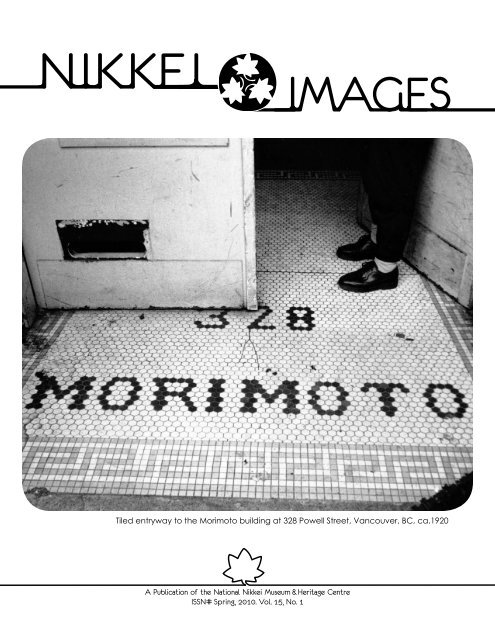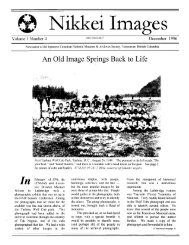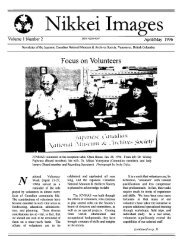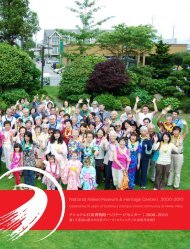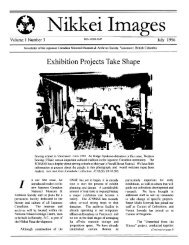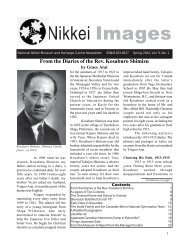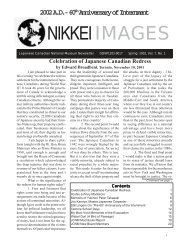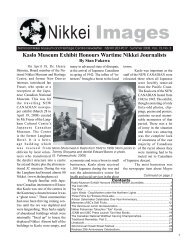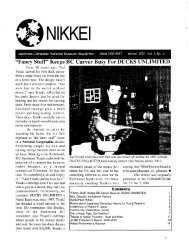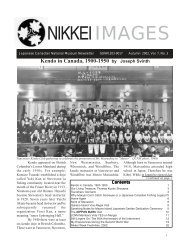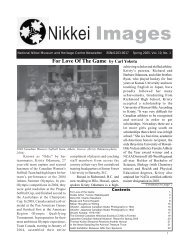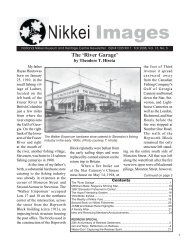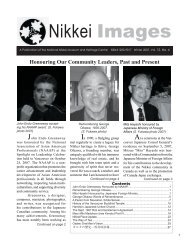Volume 15 No. 1 (PDF) - Nikkei National Museum & Cultural Centre
Volume 15 No. 1 (PDF) - Nikkei National Museum & Cultural Centre
Volume 15 No. 1 (PDF) - Nikkei National Museum & Cultural Centre
Create successful ePaper yourself
Turn your PDF publications into a flip-book with our unique Google optimized e-Paper software.
Tiled entryway to the Morimoto building at 328 Powell Street, Vancouver, BC, ca.1920<br />
ISSN# Spring, 2010. Vol. <strong>15</strong>, <strong>No</strong>. 1
The Faces of 328 Powell Street 2<br />
Big Changes with <strong>Nikkei</strong> Images 3<br />
The Hirota/Obayashi Families 4<br />
A Sewing Pattern for a Boy’s Sailor Suit 10<br />
The Tanaka Tofu Shop on Powell Street 12<br />
The Japanese Population of Steveston at the Turn of<br />
the Twentieth Century<br />
The Japanese Cemetery in Broome, Australia 18<br />
CONTENTS<br />
The Faces of 328 Powell Street<br />
With gentrification of neighbouring streets, passing through Powell Street today shows the absence of<br />
a once busy Japanese community with merchant shops, homes and schools. The community strived<br />
through tough times amidst economic hardship and conflict. One such example was the 1907 Asianriot<br />
when European-Canadians provoked by employment losses to Asian workers who were widely accepting<br />
lower wages attacked storefronts and homes in Chinatown and Japantown. All Japanese residents were forcibly<br />
relocated to other parts of B.C. or Canada in 1942, but today, though many Japanese have returned to Vancouver,<br />
it is the architecture and signage of the original buildings that tell the story of the early Japanese Canadians and<br />
reveals Japantown’s cultural past.<br />
The cover photo was taken in 1991 for the Powell Street News and Oral History Project. The existent ‘Morimoto’<br />
tile insignia at 328 Powell Street could be considered historic street typography in Vancouver. Once the<br />
entrance to U. Morimoto & Co. Dry Goods store, the strategically laid tiles have left the most recognizable mark,<br />
not just to the building, but also to Powell Street itself.<br />
Hailing from the village Hitonose in Hiroshima, Japan, Umetaro Morimoto and his family settled in the Davie<br />
Street neighbourhood of Vancouver for almost 20 years. Beginning his career as a labourer before succeeding as<br />
a businessman, Morimoto became more than an average storeowner. Persevering through the first Great War,<br />
16<br />
by Carmen Lam<br />
Morimoto became a prominent figure in the Japanese community<br />
as an art dealer, opening several stores selling Japanese art and<br />
imported goods.<br />
Although Morimoto only leased the U. Morimoto & Co. Dry<br />
Goods store from 1920-1921, the building’s occupants collectively<br />
attributed to the breadth of history it shares today. Built in 1912,<br />
the buildings’ first businesses were as a Japanese Tea Room, Japanese<br />
Rooms, and the Kane Shooting Gallery. The name of the Japanese<br />
Rooms changed to become the Stanley Rooms and then to the<br />
King Rooms, which continues to the present and are still used for<br />
accommodation. However, the Japanese Tea Room went through<br />
more dramatic changes to become a dry goods store (occupied at<br />
different times by owners Yamarichi, Higashiyama, and Morimoto)<br />
and later was the home of the Canadian Japanese Social Athletic<br />
Club in the 1920s.<br />
The 328 Powell Street building had seen its fair share of occupants<br />
in its time, from populous storefronts to the bleak occupancy<br />
of today. This building may soon be gentrified like its local neighbours,<br />
but hopefully through its changes, the signage ‘Morimoto’<br />
will be preserved and serve as a historical and cultural icon to new<br />
occupants and visitors of the area.<br />
Big Changes with <strong>Nikkei</strong> Images<br />
by Beth Carter<br />
You may notice some changes to this edition of<br />
<strong>Nikkei</strong> Images! With a streamlined new design and<br />
a new printer, the Editorial committee is very excited<br />
to present this improved edition of the inhouse<br />
journal of the Japanese Canadian <strong>National</strong><br />
<strong>Museum</strong>. The wonderful historical and cultural<br />
content will remain the same, but thanks to the<br />
design prowess of Kwantlen Polytechnic University<br />
graphic design student, Kaori Ide, we have<br />
increased the number of photographs and the<br />
page layouts are much easier to read. Thank you<br />
to Kaori for all her hard work!<br />
I would also like to take this opportunity to thank<br />
outgoing member Christine Kondo, who is leaving<br />
our committee to spend more time with her family.<br />
Christine made numerous contributions to <strong>Nikkei</strong><br />
Images and we will really miss her. Thanks!<br />
<strong>Nikkei</strong> Images is published by<br />
the <strong>National</strong> <strong>Nikkei</strong> <strong>Museum</strong> &<br />
Heritage <strong>Centre</strong><br />
Editorial Committee:<br />
Beth Carter; Stanley Fukawa,<br />
Grace Hama, Frank Kamiya,<br />
Kaye Kishibe, Linda Reid,<br />
Edzard Teubert, Mitsuo Yesaki,<br />
Carl Yokota<br />
Editorial Design:<br />
Kaori Ide<br />
Subscription to <strong>Nikkei</strong> Images<br />
is free with your yearly membership<br />
to NNMHC:<br />
Family $25<br />
Individual $20<br />
Senior/Student $<strong>15</strong><br />
Senior Couple $20<br />
<strong>No</strong>n-profit Association $50<br />
Corporate $100<br />
$1 per copy for non-members<br />
NNMHC<br />
6688 Southoaks Crescent,<br />
Burnaby, B.C., V5E 4M7<br />
Canada<br />
tel: (604) 777-7000<br />
fax: (604) 777-7001<br />
jcnm@nikkeiplace.org<br />
www.jcnm.ca<br />
www.nikkeiimages.com<br />
Disclaimer:<br />
Every effort is made to ensure the accuracy<br />
of the information contained within <strong>Nikkei</strong><br />
Images. However, due to the possibility of<br />
human or mechanical error, <strong>Nikkei</strong> Images<br />
does not guarantee the correctness,<br />
adequacy or completeness of any information<br />
and is not responsible for any errors<br />
or omissions or the results obtained from<br />
the use of such information. Opinions<br />
expressed in this publication are those of<br />
the authors and do not necessarily reflect<br />
those of the editors or of the NNMHC.<br />
2 3
1<br />
PHOTOS on page 4:<br />
Figure 1. Gitaro and Tane Hirota with Hayao. (Hirota Family photo, ca. 1912)<br />
Figure 2. 17-year old Hayao Hirota. (Hirota Family photo, 1927)<br />
Figure 3. Asakichi Obayashi. (Hirota Family photo, date unknown)<br />
Figure 4. Yonematsu and Mitsukan with their children. (Hirota Family photo, ca. 1890)<br />
Figure 5. Kakuyoshi and Tomino Obayashi. (Hirota Family photo, date unknown)<br />
The Hirota/Obayashi Families<br />
Family History Series <strong>No</strong>. 12<br />
5<br />
4<br />
by Theodore T. Hirota<br />
2<br />
3<br />
My great grandfather,<br />
Kunimatsu Hirota (1834-<br />
1890), was born in a small<br />
fishing village on the island of Yuge<br />
(You-geh). Yuge is a small island 6<br />
km long and 2 km wide and some<br />
10 sq km in area located in the Inland<br />
Sea between the mainland of<br />
Japan, Honshu, and Japan’s largest<br />
island, Shikoku, that sits on the underbelly<br />
of Japan.<br />
My grandfather, Gitaro (1874-<br />
1946), married Tane Hanaoka<br />
(1875-1956) in the 1890’s. He then<br />
shipped on a <strong>No</strong>rwegian threemasted<br />
schooner out of Yokohama<br />
in 1899 as an assistant cook. The<br />
ship sailed to San Francisco and<br />
then to New York via Cape Horn<br />
and then returned to Yokohama<br />
within a year. Two daughters, Kinue<br />
(1901-) and Kunie (1908-) were<br />
born in Yuge.<br />
Gitaro left for Canada in 1900 to<br />
fish for salmon on the Fraser River<br />
and established himself in the<br />
small fishing community of Ladner<br />
in British Columbia. He returned<br />
to Japan for his wife and together<br />
they sailed for Canada in 1908 or<br />
1909 leaving the two daughters to<br />
be raised by relatives in Yuge. My<br />
father, Hayao (1910-2001) was born<br />
in Ladner, B.C. He is shown in the<br />
photograph between his parents in<br />
a wide brimmed hat and holding a<br />
flower. He appears to be wearing a<br />
dress!<br />
Hayao was followed by three<br />
younger siblings, Masae Shimizu<br />
(1911-), Masue Umebayashi<br />
(1912-), and Suwa Hirota (19<strong>15</strong>-).<br />
All four, born in Canada, were taken<br />
to Yuge by their parents to be<br />
raised and educated in Japan. This<br />
was apparently common practice<br />
among those who could afford to<br />
accompany their children to Japan<br />
during their formative years. The<br />
date they left for Japan is unknown<br />
though it was certainly after Suwa<br />
was born and when Hayao would<br />
have been at least 5 years old.<br />
Hayao and his three younger<br />
sisters returned to Canada around<br />
1926 after Hayao had finished middle<br />
school in Yuge. He enrolled in<br />
grade school in Steveston, British<br />
Columbia but did not last a year.<br />
Having to help his father fish at<br />
night, he would fall asleep in the<br />
classroom during the day. His formal<br />
Canadian education in English<br />
was thus ended when his father<br />
needed his undivided assistance<br />
in fishing. Our second photo of<br />
Hayao was taken at the age of seventeen<br />
and he is now wearing “plus<br />
fours”!<br />
Hayao purchased a houseboat<br />
and a fishing boat for $800 in 1934.<br />
He partitioned the houseboat into<br />
two rooms and a bathroom for use<br />
during the summer fishing season.<br />
Hayao was an inveterate animal<br />
lover and took in a stray cat. Soon<br />
the houseboat was populated with<br />
a number of cats and kittens. However<br />
his idyllic life as a bachelor<br />
was quickly curtailed by overriding<br />
events.<br />
My genetic roots on my mother’s<br />
side reside in an Obayashi family<br />
from Uoshima, Japan. Uoshima<br />
(Uo means fish and shima means<br />
island) is a small island about 1 km.<br />
by 2 km. in size and three sq. km. in<br />
area and about 12 km. south east of<br />
Yuge. The population of Uoshima<br />
village in 1998 was 369 and is slowly<br />
shrinking.<br />
My great, great grandfather,<br />
Asakichi Obayashi was born in<br />
Uoshima village in the 1860’s. He is<br />
shown in the earliest known photograph<br />
of the family line wearing a<br />
suit, a ruffled collar, and a bowler<br />
hat.<br />
From his humble birth in a<br />
small fishing village in a very rural<br />
province of Japan to a point in time<br />
where he dresses in western clothing<br />
for a photograph is a story that<br />
calls out to be told but is now lost<br />
to us. He married Tami (maiden<br />
name unknown, mnu) and had one<br />
child my great grandfather Yonematsu<br />
Obayashi. Yonematsu married<br />
Mitsukan (mnu) and, unlike<br />
his father before him, proceeded to<br />
father eight children, the first being<br />
my grandmother, Asano Obayashi<br />
(1891-1987). Two of the younger<br />
sisters, Kusue and <strong>No</strong>buko, as well<br />
as two brothers, Ryozo and Michio<br />
are shown standing with their parents<br />
in a family photograph taken<br />
probably in the late 1890’s.<br />
Asano’s younger brother, Yoriichi,<br />
became the reeve of one of<br />
4 5
the many islands in the Inland Sea.<br />
Jutaro Obayashi (1873-1954), no<br />
relation, married Asano Obayashi<br />
(1891-1987) in Japan and immigrated<br />
to Canada to become what<br />
the Japanese call Issei, that is, the<br />
first generation in a new land. He<br />
began his residency in Steveston.<br />
He moved from a small fishing village<br />
on an island in the Inland Sea<br />
of Japan to a small fishing village<br />
at the mouth of the Fraser River! A<br />
daughter, Hideko (1914-2003) was<br />
born in the Japanese Fishermen’s<br />
hospital on Number One Road at<br />
Chatham Street in Steveston and is<br />
identified as a Nisei (second generation).<br />
A son, Hatsuzo (19<strong>15</strong>-1984),<br />
was born the following year. My<br />
mother, Tetsuko (1917-2003), was<br />
born on March 13, 1917. At the age<br />
of eighteen months, my mother and<br />
her older siblings, Hideko and Hatsuzo,<br />
accompanied their mother,<br />
Asano, to Uoshima. Asano returned<br />
to Canada while the children remained<br />
in Japan and were raised by<br />
an aunt Tomino (a niece of Jutaro<br />
Obayashi) and uncle, Kakuyoshi<br />
Obayashi (shown in formal dress,<br />
Obayashi home on Uoshima.<br />
(Hirota Family photo, 1987)<br />
Obayashi grave on Uoshima.<br />
(Hirota Family photo, 1987)<br />
possibly in a wedding photograph)<br />
in Uoshima.<br />
The Obayashi home, established<br />
by funds sent by Jutaro<br />
Obayashi from Canada, was rented<br />
and maintained by Kakuyoshi and<br />
Tomino. The house, still in existence,<br />
is located on the hillside at<br />
the edge of the village and overlooks<br />
the harbour below.<br />
The path up to the house is<br />
very steep. The only road in the village<br />
runs along the harbour front.<br />
Kakuyoshi’s first-born, a son named<br />
Hisashi, served in the military as a<br />
soldier and died in the war. A second<br />
son, Kensaku served in the<br />
navy and also perished in the war.<br />
Kakuyoshi’s third son, Shinobu<br />
(1922-2007), attended primary<br />
school with my mother Tetsuko in<br />
the village. The school is still standing<br />
but is now a teachers’ residence.<br />
Shinobu later traveled to the nearby<br />
island of Yuge and enrolled in the<br />
Yuge <strong>National</strong> College of Maritime<br />
Technology (first established as the<br />
Yuge Seamen’s School in 1901). He<br />
later obtained his credentials as a<br />
ship’s captain and then traveled the<br />
world. Shinobu retired from a life<br />
on the sea and lived with his wife<br />
Miyako (nee Kanaoka) (1923-) on<br />
the family property until his death<br />
in 2007.<br />
Both of Shinobu’s parents,<br />
Kakuyoshi and Tomino Obayashi,<br />
were buried in the backyard overlooking<br />
the garden. Kazue Fujita,<br />
Shinobu’s niece and his closest<br />
remaining relative in Uoshima (everyone<br />
else has left the island to<br />
find work), looked after the welfare<br />
of Shinobu and Miyako.<br />
In March of 1927 my mother<br />
and my uncle Hatsuzo returned to<br />
Canada aboard the steamship S.S.<br />
Alabama Maru bound for Victoria,<br />
B.C. Japanese who were educated<br />
in Japan and returned to Canada<br />
are called kibei. Originally, the S.S.<br />
Alabama was a 1,940-tonne, coalcarrying<br />
collier built in Newcastle,<br />
England in 1879. The ship went<br />
aground near the Eden lighthouse,<br />
New South Wales, Australia in 1916<br />
but was refloated with little damage.<br />
The ship eventually was sold<br />
to Japanese interests in 1925 and<br />
renamed the S.S. Alabama Maru.<br />
A year after the Obayashi kibei returned<br />
to Canada, a sister Teruko<br />
(1928-) was born in Steveston.<br />
Asano’s mother, Mitsu Kan was<br />
the subject of a dodoitsu (a four<br />
line, 26-syllable poem that is sometimes<br />
performed as a folk song accompanied<br />
by a three-stringed musical<br />
instrument called a shamisen)<br />
written by Mitsu Kan’s father, Shinzo<br />
Kan under the pen name “Kan<br />
Shoyen”:<br />
Momiji gonyaniya<br />
Hooki wa eranu<br />
Musume Mitsujo no<br />
Sode de haku<br />
(Author’s Translation)<br />
In the maple leaf dye shop<br />
A broom is not required<br />
Daughter Mitsujo is now<br />
Sweeping with her sleeve<br />
According to my mother, Tetsuko,<br />
the dye shop was offered to<br />
Shinzo Kan as a reward for services<br />
rendered to a lord in the area. The<br />
dye shop sold cloth to samurai warriors.<br />
Much less is known about my<br />
maternal grandfather, Jutaro. He<br />
also was an Obayashi but not related,<br />
and clearly from another island<br />
since he was married and had<br />
two children, Tameichi (m) and a<br />
girl before he left Japan for Canada<br />
with Asano. Tameichi had two children<br />
Tameko (f) and Kazutaka (m),<br />
both residing in Japan. Details regarding<br />
Jutaro’s other life came to<br />
light during a search for roots by<br />
one of the relatives. Jutaro was the<br />
first of five children born to Hide<br />
Obayashi (mnu). Her husband’s father<br />
(my great, great grandfather)<br />
was Kigiro Obayashi of whom only<br />
the name is known. Jutaro’s other<br />
siblings were Otokichi (m), Yuri<br />
(f), Yumatsu (m), and Ichizo (m).<br />
Otokichi was the most prolific of<br />
the siblings with nine children.<br />
Only two of the nine are known; the<br />
sixth-born, Sawaichi ended up on<br />
a sugar-beet farm in Alberta with<br />
my parents during the evacuation<br />
of the Japanese-Canadians from the<br />
west coast of British Columbia and<br />
the last-born sibling, Tamino married<br />
Kakuyoshi Obayashi (did he<br />
change his last name?) and established<br />
residency in the house built<br />
with funds from her uncle, Jutaro.<br />
PHOTO Left:<br />
Tetsuko Obayashi. (Hirota Family photo, ca. 1934)<br />
PHOTO Below:<br />
Engagement photograph of Tetsuko and Hayao Hirota. (Hirota<br />
Family photo, 1935)<br />
My mother, Tetsuko, returned<br />
to Steveston at age 10 according to<br />
records of the S.S. Alabama Maru.<br />
The earliest known formal photograph<br />
of Tetsuko is shown at about<br />
age 17-18. A formal photograph taken<br />
on February 14, 1935 marked<br />
her engagement to Hayao Hirota at<br />
age 18.<br />
My mother’s inordinate fear<br />
of animals ensured that dad’s menagerie<br />
of cats were banished from<br />
the houseboat and from their lives.<br />
They were married on December<br />
14, 1935 in Steveston, B.C and took<br />
up residence in a home in Ladner.<br />
My brother, Yoshiaki (Jackson)<br />
was born on September 27, 1936 in<br />
Steveston. He is a Sansei or third<br />
generation. In December 1936,<br />
Hayao purchased the Walker Em-<br />
6 7
porium that occupies lots # 17 and<br />
18 on Moncton Street opposite the<br />
Hepworth Building for the taxes<br />
that owed on the property. Hayao<br />
partitioned the former hardware<br />
store into a corner garage, furniture<br />
store, and a pool hall. Hayao’s<br />
brother-in-law, Taro Shimizu, an<br />
experienced auto mechanic working<br />
on Gore Avenue in Vancouver<br />
became a partner in the enterprise<br />
named River Garage. Hayao fished<br />
during the summer fishing season<br />
and then worked in the garage with<br />
Shimizu in the winter months. Teruyuki<br />
(Theodore) was born on September<br />
27, 1938, exactly two years<br />
to the day after his older brother.<br />
The family was evacuated on<br />
May <strong>15</strong>, 1942 to Alberta to work on<br />
a sugar beet farm near Turin north<br />
of Lethbridge. After two years of<br />
back-breaking work during the<br />
growing season and no work at all<br />
during the winter months, the family<br />
savings were nearly depleted.<br />
The family left for Chapleau, Ontario,<br />
a town 125 miles north of Sault<br />
St. Marie, to join Tetsuko’s sister<br />
and her family. Hayao began work<br />
full time as a labourer for the C.P.R.<br />
As the railway system moved from<br />
steam locomotion to diesel power<br />
in the late 1940s, Hayao used his<br />
combustion engine knowledge<br />
from his mechanic’s experience in<br />
Steveston to complete a correspondence<br />
course in diesel mechanics<br />
and advanced to a higher paying<br />
position within the C.P.R.<br />
After Bill 198 amended the Dominion<br />
Elections Act on June <strong>15</strong>,<br />
1948 such that Japanese Canadians<br />
now had the right to vote, wartime<br />
restrictions on travel to and domicile<br />
in B.C. were lifted. Eileen Sanae,<br />
a sister to Jackson and Ted, was<br />
Jackson Hirota besides the<br />
Tozan kiln near Nanaimo.<br />
(Hirota Family photo, ca. 2000)<br />
born on August 1, 1949 in Chapleau,<br />
Ontario.<br />
In the spring of 1952, Hayao decided<br />
to return to B.C. to begin fishing<br />
again after a hiatus of 10 years.<br />
Hayao, his wife Tetsuko, and Eileen<br />
left by train to a life that was no longer<br />
regulated by a company whistle<br />
in a company town but by the seasons<br />
of the year. Sons Jackson and<br />
Ted accompanied by their maternal<br />
grandparents left for B.C. after<br />
the school year was over. Jackson<br />
and Ted attended Richmond High<br />
School with many other returnees.<br />
The return of many Japanese Canadians<br />
to the west coast after seven<br />
or more years especially those<br />
whose fathers left the occupation of<br />
salmon fishing, resonates with the<br />
return of the salmon<br />
to the rivers of British<br />
Columbia, albeit after<br />
only four years at sea.<br />
Many other Japanese<br />
Canadians, perhaps<br />
the majority, did not<br />
return but instead remained<br />
where they<br />
had been scattered<br />
in Alberta, Manitoba,<br />
Ontario, and Quebec.<br />
In the majority of<br />
cases, intermarriage<br />
within the younger<br />
generations of Sansei<br />
and Yonsei (fourth<br />
generation) to non-<br />
Japanese has left and<br />
will leave their offspring<br />
with perhaps<br />
only the name as recognizably<br />
Japanese.<br />
Jackson graduated<br />
from the University<br />
of Idaho with a Masters<br />
degree in visual arts and married<br />
Gladys Schuster (1946-). Both<br />
became school teachers. They had<br />
two boys, Jonathan Michael (1975-)<br />
and Matthew James (1976-) both<br />
born in Chilliwack, B.C. Jackson<br />
helped establish the only Japanese<br />
Tozan climbing kiln in Canada on<br />
a hillside at Malaspina College in<br />
Nanaimo, B.C.<br />
Jackson retired from his art<br />
technician position at Malaspina<br />
College to continue potting and<br />
fishing recreationally for salmon.<br />
Ted graduated from the University<br />
of British Columbia, married Nancy<br />
Sakiyama (1939-) in Steveston<br />
on June 1, 1963 and went on to<br />
graduate school at the University of<br />
Toronto. Ted began teaching psychology<br />
at the University of Windsor<br />
in 1969. Two girls, Susan Elaine<br />
(1969-) and Sandra Jane (1971-)<br />
were born in Windsor. Susan, a<br />
graduate of the University of Windsor<br />
Law School, married Mark Lucier<br />
(1966-) a fellow graduate who<br />
became a teacher and they had two<br />
children, Alexandra Lauren (2000-)<br />
and <strong>No</strong>ah Daniel (2003-). Susan at<br />
present is employed by the legal<br />
department of the City of Windsor.<br />
Sandra also graduated with a degree<br />
from the university in psychology<br />
and moved to Japan in 2000 to<br />
teach English to young children.<br />
Sandra returned to live and work in<br />
Victoria, B.C. in 2006.<br />
Eileen graduated from the University<br />
of British Columbia and<br />
married Robert Gilchrist (1945-) a<br />
fellow teacher. Both received a Masters<br />
degree in counseling from the<br />
University of Arizona. They have<br />
two children, Karen Sayuri (1978-)<br />
born in New Westminster and Michael<br />
Kiyoshi (1980-) born in Kimberly,<br />
B.C. In 1987 Eileen traveled<br />
with her family on a backpacking<br />
and sight-seeing tour of Japan, with<br />
a side visit to her relatives in Yuge<br />
and Uoshima Islands in the Inland<br />
Sea. After climbing the steep hillside<br />
to Shinobu’s house overlooking the<br />
Uoshima harbor, she was taken on<br />
a hakamari (cemetery visit) to the<br />
ancestral site some distance behind<br />
Shinobu’s back garden. Another<br />
relative carrying a chabin (teapot)<br />
full of water accompanied them to<br />
the gravesite where the water was<br />
poured over the granite gravestone<br />
in a cleansing ritual of reverence. At<br />
the foot of the gravesite, Shinobu in<br />
clear and unaccented English surprised<br />
Eileen with the declaration<br />
“Here are your roots!” The emotions<br />
that were evoked brought<br />
tears to her eyes and rendered her<br />
utterly speechless. The events that<br />
had transpired to place her there at<br />
the gravesite of her ancestors and<br />
the overwhelming clarity of her<br />
genetic connection to what lay before<br />
her on this wooded slope on<br />
a miniscule island half way around<br />
the world from where she was born<br />
was not lost on her.<br />
Eileen remarried in Kimberly,<br />
B.C. in July 1996 to Brian Niven<br />
(1950-) an engineer and took up<br />
residency in Calgary, Alberta.<br />
They relocated to a 25-acre farm in<br />
the Kooteney Valley just outside of<br />
Creston to pursue Eileen’s interest<br />
in water-colour painting in the Hirota<br />
Gallery attached to her home.<br />
She presently markets both<br />
her paintings and Jackson’s pottery<br />
from the studio. She is shown in<br />
front of her home/studio with her<br />
brother Ted.<br />
The last part of this family history<br />
contains a reference to a legacy<br />
to be left for future generations.<br />
The legacy consists of a storyline<br />
that encompasses seven generations<br />
(five of which are in Canada)<br />
and stretches over about <strong>15</strong>0 years.<br />
<strong>No</strong>t long in terms of written history,<br />
in fact, a nano sec in time, but<br />
long enough for future generations<br />
to meaningfully grasp the connectedness<br />
across families and to place<br />
in perspective whatever links the<br />
connections might provide to look<br />
back to the past and to appreciate<br />
the line that extends to the future.<br />
The saddest part that I experienced<br />
in writing this family history<br />
was the lost opportunity to talk to<br />
my parents about more of what<br />
had happened in their lives and the<br />
missing information that is now unavailable<br />
that would have filled in<br />
large gaps in the chronology. Some<br />
of the information about my paternal<br />
grandfather’s travel to New York<br />
and my mother’s stories about the<br />
written poetry of her great, great<br />
grandfather are priceless nuggets<br />
that were unearthed through questions<br />
and recorded at a time when I<br />
was only casually interested in my<br />
heritage for which I am now thankful<br />
that they were not lost.<br />
8 9
The sewing pattern was cut by Yae Oikawa. Yae<br />
was the second wife of the famous Jinzaburo Oikawa.<br />
Jinzaburo Oikawa was a man who set his fortunes on<br />
Canada, becoming a luminary in a new international<br />
entrepreneurial class that emerged during the transitional<br />
period between feudal and modern times in<br />
Meiji-era Japan. He came to Canada in 1897 and built<br />
up a business, finally mortgaging Don Island on the<br />
Fraser River and setting up a colony for Japanese to<br />
immigrate to. Over the years, Jinzaburo went back<br />
and forth between Japan and Canada, shuttling Japanese<br />
men and women over. In the end, it is estimated<br />
he brought over 400 hundred people to Canada to help<br />
them begin their new life.<br />
Jinzaburo's second wife, Yae moved to<br />
Canada and there gave birth to a son, Eiji,<br />
and a daughter, Shima. This sewing pattern<br />
was used to make a sailor suit for<br />
Eiji; an outfit similar to the one worn<br />
by him, seen here in the picture with<br />
his sister. This artefact, though<br />
rich in history, is not rich in a happy<br />
history. The same year THE<br />
VANCOUVER WORLD newspaper<br />
was used to sew the sailor suit was the same year<br />
young Eiji drowned. This tragic event was something<br />
the Oikawa family never recovered from and most<br />
likely contributed to their final move back to Japan in<br />
1917.<br />
The sewing pattern brings about a sad tale but it<br />
is also a tale of perseverance, ingenuity and a mixing<br />
of cultures.<br />
Treasures of the <strong>Museum</strong><br />
A Sewing Pattern for<br />
a Boy’s Sailor Suit<br />
A Sewing Pattern for a Young Boy’s Sailor Suit made from Newspapers,<br />
c. 1912. Oikawa Family Collection, JCNM 2009.2.13<br />
by Alexis Jensen<br />
It looks like a jumble of old newspapers pinned together, right? It is nothing special, nothing overtly historical.<br />
But you would be wrong. This wondrous artefact is brimming with history and is an important piece<br />
exemplifying the interlacing of Japanese and Canadian cultures.<br />
The material used for this artefact is an abundant hodge-podge of several Japanese and Canadian newspapers<br />
like the CANADA SHINPO dated July 9th, Meiji 42 (1909) and THE VANCOUVER WORLD dated July 29,<br />
1912. Publications like CANADA SHINPO and the NEW CANADIAN show that the Japanese population living<br />
in Canada was large enough to support at least two Japanese publications. And if you look closely the advertisements<br />
in the CANADA SHINPO are in both English and Japanese. The presence of both newspapers and their<br />
bilingualism shows the integration of the seamstress's family, and the Japanese Canadian community as a whole,<br />
into Canada.<br />
In their second incarnation, the newspapers have been cut up into a sewing pattern to make a young boy's<br />
sailor suit. Again this shows the joining of cultures with Japanese women applying their traditional sewing techniques<br />
and skills to a Canadian-style outfit - that of a little sailor.<br />
A Studio Portrait of three year old Shima<br />
(left) and five year old Eiji (right) Oikawa,<br />
Before 1912. Oikawa Family Collection,<br />
JCNM 2009.2.74<br />
10 11
The Tanaka Tofu Shop<br />
on Powell Street Memories of Min and Bud Tanaka<br />
Bud, Bill, Min, Mike, Miki<br />
and Sam Tanaka (aged 88,<br />
86, 84, 82, 80 and 78) are six<br />
of the eight surviving Tanaka siblings<br />
whose parents owned a tofu<br />
shop on Powell Street in Vancouver’s<br />
Japantown until 1942 when, as<br />
<strong>Nikkei</strong>, they were forced to leave<br />
the Pacific coast. From the brothers’<br />
memories, we are able to tell<br />
the story of their family business<br />
before WWII. An earlier issue of<br />
<strong>Nikkei</strong> Images had this description<br />
of the Tanaka tofu shop.<br />
At the back of 451 was the<br />
Tanaka Tofu establishment. Mr.<br />
Tanaka owned the building and<br />
rented it out to stores in the front<br />
with residences in the back, and<br />
ran his business in the back from a<br />
separate building. [<strong>Nikkei</strong> Images,<br />
July 1997, p. 4, Judy Inouye script<br />
for the JCNM walking tour, a part<br />
of the Powell Street Festival: which<br />
began in 1977.]<br />
The parents were Ichijiro and<br />
Miki (nee Tsuji) who emigrated<br />
from Hassaka, a village near Hikone<br />
in Shiga prefecture. Ichijiro was<br />
born in 1886 and arrived in Canada<br />
in 1903. Miki was born in the same<br />
village in 1891 and came as a picture<br />
bride in 1911. They eventually had<br />
ten children, one son dying within a<br />
month of birth, one daughter when<br />
she was 19. The other two survivors<br />
are Sayo Hattori age 96 and<br />
Masa Yada, 91.<br />
Recorded by Stan Fukawa / Edited by Mickey Tanaka<br />
Mr. and Mrs. Tanaka at their 50th anniversary celebration, 1961.<br />
Tanaka Family photo.<br />
Tanaka Children, 1941. Tanaka Family photo.<br />
L – R: Osamu Sam, Shigeru Bill, Mitsuru Miki, Kazuo Bud,<br />
Masako, Minoru, Akira Mike<br />
The Tanakas opened their<br />
business in 1913 when the original<br />
owner of the tofu shop, Miwa Ono<br />
returned to Japan. Before opening<br />
the tofu shop, Ichijiro worked in<br />
sawmills in Vancouver and Tacoma.<br />
Miki did some housework and<br />
cooking in a boarding house. Being<br />
from Shiga prefecture, he came<br />
from a region renowned for its Omi<br />
Shonin entrepreneurial spirit. Omino-kuni<br />
or Go-shu was the fiefdom<br />
which became Shiga prefecture after<br />
the Meiji Restoration.<br />
There is a learned society today<br />
called the Omi Shonin Research Society<br />
which has been studying the<br />
legacy of the entrepreneurial tradition<br />
of Shiga prefecture in some of<br />
the largest corporations in Japan<br />
and even among immigrants to<br />
Canada. A Japanese scholar, Prof.<br />
Toshiji Sasaki, noted in Nihonjin<br />
Kanada Imin-shi that in the prewar<br />
period, almost half the merchants<br />
in Vancouver’s Japantown were<br />
from Shiga prefecture although<br />
they were only 20 percent of Japanese<br />
immigrants to Canada. Being<br />
of that tradition, they were more<br />
likely to take a commercial path as<br />
the next step up in their life histories<br />
rather than buying farmland or<br />
a fishing boat. (See <strong>Nikkei</strong> Images,<br />
Autumn 2001 for the biography of<br />
another Shiga prefecture immigrant<br />
to Canada, Sataro Kuwahara,<br />
who established a retail business<br />
in Calgary which was expanded by<br />
his sons, Hiroshi and Tom.)<br />
The Tanaka tofu shop is shown<br />
on the JCNM map of Japantown as<br />
451B Powell St. but it did not front<br />
onto Powell St. It was actually located<br />
on the lane behind Powell St. and<br />
accessed by a narrow breezeway<br />
connecting Powell St. to the lane.<br />
This breezeway was closed and<br />
built over not that long ago when,<br />
for a time, a post-WW II nisei, Shig<br />
Hirai, whose parents came from<br />
Shiga prefecture, opened a branch<br />
of his Fujiya chain next door. Prior<br />
to 1942, Mr. Tanaka rented out<br />
space in the building at 451A Powell<br />
St.<br />
The brothers guess that their<br />
mother, Miki woke around 4 a.m.<br />
every morning to begin the tofu<br />
making. She had to complete the<br />
first two or three batches of tofu before<br />
the Japanese peddlers picked<br />
up their orders at 6 a.m. to sell on<br />
their rounds in the outer areas of<br />
the Vancouver Japanese community<br />
like Kitsilano and Fairview. The<br />
nearby grocery stores were supplied<br />
with not only the Tanaka tofu<br />
but also the product of their competition<br />
- there were three other tofu<br />
shops in Japantown at that time (see<br />
details below). Mr. Tanaka or the<br />
boys delivered to the local shops<br />
and even to families as far away as<br />
Seymour St.<br />
There was a lot of work in making<br />
the tofu. After the soy beans<br />
were soaked overnight to soften,<br />
they were ground with added water<br />
through a stone mill turned by<br />
an electric motor. (The stones have<br />
been donated to the JCNM). The<br />
sons remember that there was a lot<br />
of o-kara (“bean curd lees” or residue<br />
consisting mainly of the shell<br />
of the bean) compared with what<br />
would be left today because of the<br />
advancement in machinery. The o-<br />
kara which they gave away to customers<br />
who came by was but a small<br />
portion of the quantity of fibrous<br />
residue created in the tofu-making<br />
process. Most of it was put into 45-<br />
gallon drums to be taken away by<br />
pig farmers, probably for free. It is<br />
a very nutritious by-product but it<br />
requires the addition of expensive<br />
ingredients to make it taste good.<br />
Mary Ohara has included an o-kara<br />
recipe as part of her “Internment<br />
Recipes” in the cook book “Everyone’s<br />
a Chef” published by the<br />
Auxiliary of the <strong>Nikkei</strong> <strong>Museum</strong><br />
and Heritage <strong>Centre</strong> in 2006. This<br />
includes bacon and shiitake mushrooms<br />
and chikuwa (fish-cake),<br />
making it a fairly expensive recipe<br />
for the tough times that characterized<br />
most of the pre-war period in<br />
the <strong>Nikkei</strong> community.<br />
The ground beans, the milk<br />
and the water was boiled before<br />
filtering - first through a coarse<br />
cloth bag and then through a fine<br />
one. The lees were squeezed to obtain<br />
every drop of soy bean liquid<br />
to which was added a traditional<br />
sea-water-based coagulant called<br />
nigari and gently stirred until the<br />
slurry began to curdle and set. It<br />
was then poured into a wooden box<br />
lined with a fine cloth. Controlled<br />
pressure was applied to remove<br />
the water which drained through<br />
openings in the box. After the tofu<br />
had set it was sliced into cubes and<br />
placed in a large tub (ikesu) with<br />
running cold water in an era before<br />
widespread refrigeration.<br />
The wooden box’s inside dimensions<br />
were 10 inches by 28<br />
inches by 10 inches. Since the tofu<br />
in the box was cut into 14 pieces,<br />
each piece was 5 inches by 4 inches<br />
by 4 inches and was thought to<br />
weigh about a pound. According to<br />
earlier descriptions at the JCNM,<br />
in the earliest days of the Tanaka<br />
shop, they sold tofu for five cents a<br />
piece and produced about 50 cakes.<br />
By 1941, their production was up to<br />
12 13
250 cakes a day and they sold for<br />
ten cents .<br />
Some of the tofu was deepfried<br />
to make abura-age or aburage<br />
which could be split to make the<br />
Inari zushi or be used as a sort of<br />
meat substitute for those occasions<br />
when meat was avoided for<br />
religious reasons. In those days,<br />
Buddhists often marked significant<br />
anniversaries of the death-days of<br />
ancestors by observing the traditional<br />
Buddhist meat prohibitions<br />
which were introduced to Japan in<br />
the sixth century. Aburage sold at<br />
three for ten cents.<br />
Another tofu product which<br />
they remembered their mother<br />
making was what she called hiryozu<br />
- a deep-fried tofu dish with<br />
seeds and vegetables inside. Contemporary<br />
cook books describe<br />
ganmodoki (its present name) as a<br />
deep-fried dish made of crumbled<br />
tofu with yama-imo (a type of yam),<br />
sesame seeds and finely chopped<br />
vegetables such as gobo (burdock),<br />
carrots, onions, gingko nuts. These<br />
are shaped into three-inch patties<br />
or one-and-a-half inch balls. In the<br />
Tanaka shop this was made from<br />
day-old tofu which was difficult to<br />
keep fresh for very long in just running<br />
water. Min Tanaka is amazed<br />
at the length of time commercial<br />
tofu keeps today before reaching<br />
the “Best Before” date.<br />
Besides tofu products, the<br />
Tanakas made and sold konnyaku<br />
which is a gelatinous product included<br />
in such traditional dishes<br />
as o-den. Konnyaku does not have<br />
much flavour but is valued for its<br />
texture. Konnyaku in those days<br />
sold for five cents for a 4 inch by 4<br />
inch by 1 inch piece.<br />
The Wakabayashi family had a<br />
Millstones from the Tanaka Collection (JCNM 1997.8.10)<br />
Water heavy soy beans were boiled and then ground<br />
between the two stones during the tofu making process.<br />
tofu shop at 439 ½ Powell St. right<br />
next door to them in the lane and<br />
the Tanakas marvel at the fact that<br />
relations were very cordial between<br />
the two families despite their being<br />
rivals in the same business. “Our<br />
tofu was softer, but the Wakabayashi<br />
aburage was better for making Inari<br />
zushi because it split open much<br />
more easily. The two other shops<br />
producing tofu in Japantown were<br />
the Chiba shop at 206 Main and the<br />
Miyazaki shop at 216 Gore. One of<br />
the chores of the Tanaka children<br />
was to stamp the Tanaka name on<br />
the paper used to wrap the tofu so<br />
that when customers saw it in the<br />
grocery stores alongside tofu from<br />
other shops, they could identify it.<br />
They still remember which grocers<br />
and fish shops carried their tofu.<br />
Growing up in the Powell St.<br />
neighbourhood across the street<br />
from Oppenheimer Park, the children<br />
lived the life of Vancouver Nisei<br />
- attending Strathcona Elementary<br />
and Brittania High, as well<br />
as the Japanese Language School<br />
after English school was over. The<br />
other large minority group was the<br />
Chinese and although China and<br />
Japan were not on good terms internationally,<br />
it seems that locally<br />
when there was a race-fight, the<br />
Asians stuck together against the<br />
white kids. The Asahi baseball<br />
players were, of course, the neighbourhood<br />
heroes.<br />
When the Pacific War began<br />
and the government announced<br />
a plan to forcibly move all <strong>Nikkei</strong><br />
away from the Pacific coast, Mr..<br />
Tanaka opted to move the family to<br />
a “self-supporting community” in<br />
1942 rather than face being split up<br />
with adult males aged 18-45 (Mr..<br />
Tanaka and two sons) being sent<br />
to road camps and women, children<br />
and elderly males being sent<br />
to government-built internment<br />
camps in the Kootenays. The “selfsupporting”<br />
designation meant that<br />
they had to build their own houses<br />
and rely completely on their own<br />
resources for their survival. The<br />
family took their tofu-making equipment<br />
with them to Lillooet but only<br />
made tofu after a few years when<br />
requested to do so by a neighbour,<br />
Mrs. Kaminishi. They only made<br />
it about once a week in Lillooet as<br />
they had no electric motor and the<br />
boys had to take turns supplying<br />
the muscle power to grind the soy<br />
beans.<br />
After the lifting of the restrictions<br />
on travel and settlement on<br />
Japanese Canadians in 1949, the<br />
family returned to the coast with<br />
children dispersing to schools and<br />
jobs. They did not re-enter the tofu<br />
business.<br />
Looking back, the brothers<br />
think that what happened due to the<br />
war was good for their mother who<br />
was saved from those long hours<br />
day after day as a tofu-maker in<br />
Vancouver. In Lillooet, Mrs. Tanaka<br />
also learned the secret of making<br />
the abura-age so that it would<br />
split better and be more suited to<br />
making Inari zushi - it was doublefrying.<br />
This had eluded her until it<br />
was too late to be of any commercial<br />
benefit. Mr.. Tanaka died in<br />
1982 (aged 96) and Mrs. Tanaka in<br />
1981 (aged 90).<br />
By coincidence a post-war tofu<br />
Tanaka Family History Form.<br />
maker who also started on Powell<br />
Street but of Chinese descent, has<br />
since become the most successful<br />
tofu-maker in Canada. That family<br />
still owns the Sunrise Produce<br />
Market at Powell St. and Gore Ave<br />
where they began making tofu<br />
from a back room to sell to their<br />
customers. Their side-business<br />
benefited from the tremendous<br />
boom in tofu and related soy products<br />
in <strong>No</strong>rth America starting at<br />
that time. Health-conscious people<br />
discovered the dangers of red meat<br />
and animal fat and began trying to<br />
overcome their taste prejudices.<br />
Since then, denser variants of tofu<br />
have morphed into vegetarian weiners<br />
and burgers and ground round,<br />
while lighter variants have become<br />
desserts.<br />
The Sunrise company grew<br />
fairly quickly, initially expanding by<br />
purchasing tofu making equipment<br />
from Japan to raise their production<br />
to one thousand pounds of tofu<br />
per day. Today, they have about<br />
300 employees across Canada and<br />
make 5 tonnes of tofu per day and<br />
are a multi-million dollar industry.<br />
<strong>No</strong> doubt, the increase in Asian immigration<br />
has played a large role in<br />
increasing the demand for tofu as<br />
well as the growth in popularity<br />
of Asian cuisine. As in many commercial<br />
ventures, timing was a key<br />
factor.<br />
Mike Tanaka says that their<br />
mother discouraged the sons from<br />
going into the tofu business when<br />
they returned to the coast because<br />
she thought the work too hard and<br />
the hours too long. Of course, she<br />
had not envisioned the development<br />
of machinery to change the<br />
working conditions. It is still anyone’s<br />
guess as to what might have<br />
14 <strong>15</strong>
happened if any of the Japanese<br />
Powell St. tofu makers had continued<br />
in the business through the<br />
war years and beyond. We might<br />
all be eating Japanese tofu instead<br />
of the Chinese varieties to which<br />
we have become accustomed.<br />
The twenty nine years in the<br />
tofu business may have been arduous<br />
but if the Tanaka family is any<br />
indication, eating lots of tofu more<br />
than makes up for those hardships.<br />
Father Ichijiro lived to 96, mother<br />
Miki to 90 and the children are following<br />
their example in living to a<br />
good age.<br />
Errata - Winter 2009<br />
Twice was Nice: Page 4<br />
We apologize for miscaptioning<br />
Malcolm Brodie who is<br />
the Mayor of the City of Richmond<br />
(rather than Malcolm<br />
Campbell)<br />
Shoji Nishihata: Page 16<br />
Ray Otsu should have been<br />
Ray Ota and the boys were<br />
sponsored by Komajiro Nishihata.<br />
Nakamura Florist:<br />
Page 22<br />
Unidentified person should<br />
be Misa Nakamura.<br />
The Japanese Population<br />
of Steveston at the<br />
Turn of the Twentieth<br />
Century<br />
by Mitsuo Yesaki<br />
<strong>No</strong> one knows when the Japanese first arrived in the Steveston area,<br />
though they probably arrived soon after the establishment of a fishing<br />
camp. A fish barge to collect salmon was anchored beside a slough on<br />
the southwest corner of Lulu Island by Marshall English to supply the<br />
Brownsville Cannery he built near New Westminster in 1878. During<br />
the initial years of the camp, most of the fishermen remained in the Steveston<br />
area only for the two-month duration of the sockeye salmon season.<br />
With the end of fishing, the Japanese fishermen left to find work<br />
in the major population centers, lumber camps and mills, and charcoal<br />
kilns. A few Japanese may have remained to build skiffs during the offfishing<br />
season.<br />
The present estimates of the population of Steveston for 1891, 1901<br />
and 1911 were gleaned from the copies of the original national census<br />
lists available on microfishe. For this study, Steveston was arbitrarily<br />
defined as the area bounded by the Gulf of Georgia on the west, Steveston<br />
Highway (Number 9 Road) on the north, Number 2 Road on<br />
the east and the Fraser River on the south. Harold Steves assisted in<br />
determining the people to be included within the Steveston Highway<br />
and Number 2 Road boundaries by identifying known persons on the<br />
census lists.<br />
The salmon canneries on the Fraser River developed in the 1870s<br />
around New Westminster as it was the population center of the Lower<br />
Mainland. However, the fishing grounds soon shifted from the New<br />
Westminster area to the mouth of the Fraser River. Consequently, Marshall<br />
English closed the Brownsville Cannery and built the English<br />
Cannery in 1882 on the fishing camp site to be closer to the fishing<br />
grounds. With the establishment of canneries in the Steveston area,<br />
people took up residence in the area, including a few Japanese fishermen<br />
with families and boat builders. By 1891, there were four canneries<br />
on Steveston waterfront. The census of that year shows a total of 55<br />
Japanese (Table 1). Ten years later, there were approximately <strong>15</strong> operating<br />
canneries. The 1901 census shows the population of Steveston<br />
increased by 400, all of which resulted from the influx of Japanese. An<br />
increase of 100 Caucasians was countered by a comparable decrease in<br />
the number of Chinese. The off-fishing season population of Steveston<br />
stabilized at slightly over 1,000 in 1911. The increase in numbers of<br />
Japanese was compensated by the decline of the Chinese. The Chinese<br />
provided most of the manual input<br />
that powered the salmon canneries<br />
in the early years of the industry.<br />
With increasing mechanization of<br />
the various canning processes, Chinese<br />
workers became redundant,<br />
resulting in their decline in the<br />
Twentieth Century.<br />
The original Japanese immigrants<br />
to Steveston were essentially<br />
fishermen. They were slowly<br />
joined by wives and picture brides,<br />
so the percentage of women increasing<br />
from 4% to 11% from 1891<br />
to 1901 (Table 2). The “Gentleman’s<br />
Agreement” of 1908 limiting<br />
the number of male Japanese<br />
immigrants to Canada encouraged<br />
the influx of women. The number<br />
of adult females more than doubled<br />
in 1911 (28%), while that of males<br />
decreased.<br />
The number of Japanese lodgers<br />
decreased by half from 1901 to<br />
1911, reflecting the breakdown of<br />
the fishing boss system of contracting<br />
fishermen by the fishing companies<br />
(Table 3). Increasingly, Japanese<br />
were opting to own their own<br />
boats and fishing gear, and negotiating<br />
directly with the companies.<br />
Fishermen interested in remaining<br />
in British Columbia arranged for<br />
wives and brides to join them and<br />
started raising families.<br />
The occupations of Japanese<br />
males in Steveston did not change<br />
significantly from 1901 to 1911<br />
(Table 4). The most significant<br />
shifts were the decline in the number<br />
of fishermen and an increase<br />
in farmers. Low catches from the<br />
overfished non-dominant sockeye<br />
salmon runs prompted Japanese<br />
fishermen to leave the fishery and<br />
for a few to take up farming.<br />
The businesses in Steveston<br />
changed tremendously during its<br />
first 30 years. Caucasians owned<br />
all the businesses in 1891(Table<br />
5). There was an almost four-fold<br />
increase in 1901, of which all but<br />
two businesses were Caucasianowned.<br />
In 1911, the total number<br />
of businesses remained essentially<br />
the same, but ownership by Caucasian<br />
declined to half. Japanese ownership<br />
of businesses climbed from<br />
2 in 1901 to 13 in 1911. The low<br />
number of Japanese businesses at<br />
the turn of the century is probably<br />
underestimated as data from the<br />
census shows the number of Japanese<br />
males involved in business<br />
during these years were similar.<br />
This probably resulted from shop<br />
owners originally operating from<br />
homes and not registering their enterprise<br />
with the municipality. Also,<br />
shop owners probably did not apply<br />
to be listed in the directories.<br />
Table 3. Population Structure of the Japanese Community<br />
Year Head Wife Sons Daughters Lodgers Brothers Sisters Domestic<br />
1901 2 85 40 14 9 302 2 - 6<br />
1911 3 141 109 74 65 162 11 1 3<br />
Table 4. Occupations of the Japanese Males<br />
Year # Males Fisherman Carpenter Business Farmer Other<br />
1901 2 392 336 34 11 1 10<br />
1911 3 321 254 30 14 12 11<br />
References:<br />
1 - Hillman, Thomas A., 1666 -1891. Catalogue<br />
of Census Returns on Microfilm.<br />
Public Achives Canada. British Columbia,<br />
District- New Westminster (2),<br />
Sub-district - Richmond (e-1), microfilm<br />
# T-6290.<br />
2 - Hillman, Thomas A., 1901. Catalogue<br />
of Census Returns on Microfilm.<br />
<strong>National</strong> Achives of Canada. British Columbia,<br />
District - New Westminster (2),<br />
Sub-district - Richmond (e-1), microfilm<br />
# T-6429.<br />
3 - www.collectionscanada.gc.ca., Census<br />
of Canada 1911, British Columbia, District<br />
- New Wetminster (11), Sub-district<br />
- Richmond, Lulu Island, Richmond (17).<br />
4 - Williams’ British Columbia Directory<br />
1891. R.T. Williams, Publisher, Victoria,<br />
BC. 1891.<br />
5 - Henderson’s British Columbia Gazetteer<br />
and Directory 1901. Henderson<br />
Publishing Company Ltd., Winnipeg,<br />
Victoria and Vancouver. 1901.<br />
6 - Henderson’s Greater Vancouver, New<br />
Westminster and Fraser Valley Directory<br />
1911. Henderson Publishing Company<br />
Ltd., Winnipeg, Victoria and Vancouver.<br />
1911.<br />
Year<br />
Table 1. Population of Steveston by<br />
<strong>National</strong>ity<br />
Caucasian<br />
Chinese<br />
Japanese<br />
Total<br />
1891 1 243 358 55 656<br />
1901 2 343 266 461 1070<br />
1911 3 347 136 566 1049<br />
1<br />
- Census of Canada, 1891; 2 - Census of<br />
Canada, 1901; 3 - Census of Canada, 1911.<br />
Table 2. Sex Ratio of Japanese<br />
Year Male Female<br />
1891 1 53 2<br />
1901 2 392 46<br />
1911 3 321 123<br />
Table 5. Number of Businesses<br />
Year Caucasian Chinese Japanese<br />
1891 4 12 - -<br />
1901 5 42 - 2<br />
1911 6 23 9 13<br />
4<br />
- Williams’, 1891; 5 - Henderson’s, 1901; 6 -<br />
Henderson’s, 1911<br />
16 17
The Japanese Cemetery<br />
in Broome, Australia<br />
Pinctada Maxima - mother of pearl shell<br />
Text and photographs by Stanley Fukawa<br />
Akira Masuda from Taiji, Wakayama<br />
tralia’s tropical northern frontier had to turn to Asian<br />
immigrants in those times because the climate was too<br />
severe to attract enough white workers to fill all the<br />
jobs. In the sugar cane fields of Queensland, Japanese<br />
farm workers were imported for a few years to bring<br />
in that crop. In the pearl shell industry, the Japanese<br />
proved to be such good workers before the laws were<br />
passed that after the White Australia Policy was adopted,<br />
employers quickly found ways to circumvent those<br />
laws.<br />
Broome became an important destination because<br />
of its proximity to quantities of the giant mother-ofpearl<br />
oyster, the pinctada maxima, from whose shells<br />
were crafted the beautiful buttons and mother-of-pearl<br />
luxury items created by the world’s high-fashion<br />
dressmakers and designers, as well as the many more<br />
modest manufacturers. Initially, these shells were<br />
harvested in shallow waters by aboriginal divers who<br />
worked without any specialized gear. As these beds<br />
Over nine hundred deceased are represented<br />
by headstones and memorials in the Japanese<br />
cemetery in Broome Australia. Some of the<br />
names in stone are of men not buried there but lost at<br />
sea due to the cyclones that ravage the coastline. They<br />
died because they worked in an extremely dangerous<br />
occupation that brought them good money, the respect<br />
of their peers and even the respect of the whites who<br />
generally thought them to be of an inferior race. The<br />
rows of headstones, carved in Japanese characters,<br />
have similarities with the military cemeteries in Europe<br />
that lie outside their small towns and date back<br />
to the same era. The dead are mostly young men far<br />
from home - victims of historical circumstance.<br />
It was a surprise to learn that there could be such<br />
a concentration of Japanese in a country notorious<br />
for its White Australia Policy dating to 1901. Is there<br />
anywhere in continental <strong>No</strong>rth America a site with as<br />
many Japanese graves in one place? Apparently, Auswere<br />
depleted, the search led to deeper and deeper<br />
waters, requiring diving suits and more professional<br />
personnel.<br />
As it turns out, Japanese divers were the most<br />
successful and the Australian pearl shell industry recruited<br />
them because they were the best and brought<br />
the most profit to the owners<br />
of the harvesting boats and related<br />
businesses. Despite the<br />
racist attitudes common in the<br />
British Empire of the time and<br />
the imposition of language testing<br />
to screen the undesirable<br />
non-whites out of the immigrant<br />
stream, there were ways that influential<br />
men could get the workers<br />
they wanted without their<br />
having to pass the language test.<br />
An indenture system was created<br />
to allow Japanese divers to be<br />
brought in for three-year terms.<br />
During this time, they were at<br />
the mercy of their employers<br />
who could cancel their sponsorship<br />
and send them home at any<br />
time. The good workers were<br />
renewed every three years.<br />
Part of the advantage of the<br />
Japanese divers was their working<br />
in teams on board ships that<br />
had workmates on whose diligence<br />
not only their livelihoods<br />
but also their very lives depended.<br />
Each ship had two divers and<br />
each diver when in the water had a tender who kept<br />
constant contact with him and made sure that he was<br />
safe through the lifeline and air line and the signals<br />
communicated through tugs on the lifeline. The fifth<br />
Japanese on many of these crews was the engineer.<br />
The others were often Malays or other Asian workers.<br />
<strong>No</strong>t only was the common language important but being<br />
from the same village or region in Japan meant<br />
a common background of expectations and comfort.<br />
The first diver was the boat captain, the tenders and<br />
engineer were in apprenticeship positions and could<br />
become divers themselves—learning by watching and<br />
listening. Communication was vital to learning and<br />
teaching and building trust. All crewmen were part of<br />
an economic team that shared in the catch—the shells<br />
gathered by the divers.<br />
On the dark side of the lucrative pearl shell harvest<br />
lay deadly risks. The perils of deep-sea diving<br />
came from the crude technology of the time, the common<br />
diving ailment known as<br />
“the bends,” sharks, the dangerous<br />
storms on the north coast of<br />
Australia, and diseases such as<br />
beriberi which were not well understood.<br />
Weather forecasting<br />
was rudimentary and sudden<br />
storms sank many ships. It is estimated<br />
that about ten per cent of<br />
the men, on average, died over<br />
the years, due to such causes.<br />
For divers, the risk was as high<br />
as fifty per cent in bad years.<br />
The headstones are a clear reminder<br />
of the toll taken.<br />
During the heyday of the<br />
pearl shell industry from around<br />
1890 to the late 1920s, there were<br />
over 400 pearl shell harvesting<br />
boats (called ‘luggers’), and 3500<br />
men in the town of Broome. Of<br />
these over 2000 were Japanese,<br />
with the rest being Malay, Filipino,<br />
Chinese, ‘Koepangers’<br />
(from islands north of Australia,<br />
arriving via Timor), aborigines<br />
and Europeans. Whites were<br />
a minority in this multicultural<br />
community but were the most rich and powerful. The<br />
downtown area of Broome is today called Chinatown<br />
but in earlier times was referred to as Japtown where<br />
the boarding houses, shops, restaurants, brothels,<br />
bars and gambling dens were situated. Two street addresses<br />
that survive to this day are Johnny Chi Lane<br />
and Sheba Lane--the latter derived from the Japanese<br />
name Shiba and not the Biblical Queen—after the<br />
Asian merchants who leased property there.<br />
Broome’s multiracial composition and racial pecking-order<br />
were most clearly exemplified by the seating<br />
in Sun Picture Gardens, a movie theatre, with discriminatory<br />
seating and ticket prices. It was established in<br />
Statue of Diver, Chinatown, Broome<br />
Continued on next page<br />
18 19
1916 to show cinema on a large site previously<br />
owned by a very successful Japanese<br />
merchant as an Emporium. White people<br />
paid 2s. 6p. (two shillings, sixpence) and sat<br />
in chairs with cushions; Japanese paid the<br />
same but sat behind the whites. Chinese<br />
and half-castes paid 2s. and sat in deckchairs;<br />
islanders and Malays paid 1s. 6p.<br />
and aboriginals paid 1s. The seats were less<br />
comfortable as prices dropped. Announcements<br />
were made in English, Chinese, Japanese<br />
and Arabic. Amazingly, segregated<br />
seating by race was abolished only in 1975<br />
despite protests and boycotts.<br />
Earlier, in response to the demands of<br />
the Japanese divers for better medical care,<br />
a Japanese doctor was brought in in 1910<br />
against the opposition of the local Australian doctor<br />
and many of the whites who felt that a Japanese doctor<br />
could not possibly be as good as a white one. Even<br />
if the Japanese doctor were to be as good, that was<br />
also opposed because it would undermine the belief in<br />
the superiority of the white race. Dr. Suzuki proved to<br />
be an excellent doctor and many whites called on him<br />
in preference to the other one.<br />
The belief in the racial superiority of whites and<br />
especially of Anglo Saxons was important to many<br />
Australian whites and it rankled many of them to see<br />
that the smaller Japanese were the best divers and<br />
therefore the best-paid workers in the pearl shell industry.<br />
Just before the First World War, they called<br />
upon a crack team of 12 former Royal Navy divers to<br />
come to Australia to undertake trials to help set up a<br />
training program to enable white divers to assert their<br />
proper place and obtain the reward which was being<br />
taken by members of an inferior race. This was called<br />
the White Experiment.<br />
The story of this experiment is told in John Bailey’s<br />
The White Divers of Broome, (Macmillan, 2001) – an<br />
award-winning book which has gone through 7 printings.<br />
This attempt to restore the pride and supremacy<br />
of the white race ended in dismal failure after three of<br />
the divers died and it became apparent that the white<br />
divers were abysmal in their ability to find pearl shells.<br />
They could dive to great depths and undertake military<br />
assignments but this was not enough to succeed<br />
in the pearl shell harvest. The physical and mental<br />
Diver's lead boots next to helmet<br />
strain of the loneliness and long hours was too difficult<br />
for them to endure. The plan had to be abandoned.<br />
About half of the Japanese men in Broome have<br />
been from Wakayama prefecture. With the coming of<br />
the Second World War, most of them were repatriated<br />
to Japan and the remainder sent to internment camps<br />
in the Australian interior. After the war, the pearl shell<br />
industry was revived on a smaller scale because the<br />
world’s buttons were by then mostly made of plastic<br />
and nylon. In 1955, a hundred men from the Taiji area<br />
of Wakayama were recruited to work in the pearl shell<br />
harvest based on pre-war diving methods. As in Canada,<br />
the immigration laws did not permit the free entry<br />
of non-whites until the late 1960s, so that they entered<br />
Australia under indenture contracts.<br />
Such indenture contracts date back to the beginning<br />
of the 20th century when entry began to be denied<br />
on the basis of race and did not allow the Japanese<br />
workers to bring wives.. As almost no Japanese<br />
women were allowed entry on their own after 1901, a<br />
huge gender imbalance resulted, encouraging those<br />
men who wanted long-term female companionship to<br />
cross racial lines. There have been a few cases of Japanese<br />
marrying white women but more often with aboriginal<br />
or mixed-race women. Even the latter unions<br />
were discouraged by the pre-WWII authorities. The<br />
results of such unions can be seen in the makeup of<br />
the Japanese communities in Australia today<br />
In present-day Broome, there are a few retired and<br />
aged divers from the post-war intake but not many other<br />
full-blooded Japanese permanent residents. Most<br />
residents with Japanese surnames are of mixed-blood.<br />
A few streets bear Japanese names but the people who<br />
live on them are usually not Japanese and the annual<br />
Shinju Matsuri (Pearl Festival) has a Japanese name<br />
but it is multicultural like the people, meaning that<br />
it features celebrations of Japanese, Chinese, Malay<br />
and Indonesian cultural festivities and aboriginal-influenced<br />
contemporary musical concerts.<br />
With the pearl shell industry in steep decline,<br />
Broome has adapted well and has become the world<br />
centre for cultured pearls in an industry developed<br />
by Japanese and Australian investors closely tied to<br />
the Japanese pearl industry. The warm waters off the<br />
Plaque with History of Japanese Cemetery<br />
northern Australian coast enable pearls to grow at<br />
double the rate of those in Japanese waters and today<br />
this corner of Australia accounts for a majority of the<br />
world’s supply of cultured pearls. It is a trade worth<br />
hundreds of millions of dollars annually.<br />
On August 25-27, 2008, as part of the Shinju Matsuri,<br />
a company mainly of Japanese migrant artists living<br />
in Australia, presented a program called In Repose.<br />
It included workshops for students, musical and dance<br />
performances and exhibits focused on those buried at<br />
the Broome cemetery and their contribution to the<br />
community. On the 26th, the main performance was<br />
held at the cemetery just before sunset.<br />
Australia has undergone an amazing about-face in<br />
its recognition of aboriginal rights. For most of the<br />
20 21
first two centuries of white colonization and settlement,<br />
there was no recognition at all of aboriginal<br />
rights to the land. The long prevailing concept of terra<br />
nullius put forth the idea that pre-colonial Australia<br />
had been an “empty land” not owned by anyone. Latecomers<br />
could simply take it over without negotiating<br />
with the original inhabitants or compensating them.<br />
In the last two decades, large land claims have begun<br />
to be recognized. In acknowledgment of the ownership<br />
rights of the traditional inhabitants, every public<br />
event in Australia now begins with a short welcoming<br />
speech by a representative of the traditional owners of<br />
the land.<br />
At the Broome In Repose performance, Mrs. Doris<br />
Edgar, represented the Yawuru People and welcomed<br />
the crowd in her language translated by her daughter<br />
into English. She mentioned that her grandfather was<br />
Japanese and was buried in that cemetery. In the audience<br />
was Akira Masuda, a retired Japanese diver who<br />
had come to Broome in 1955 with other Taiji men. He<br />
had a brother and a son buried in the cemetery. With<br />
him was his wife, a person of aboriginal descent and<br />
also their daughter, an organizer of the annual Shinju<br />
Matsuri .<br />
Pearl Hamaguchi, another leading member of<br />
the Broome Japanese community also participated<br />
in the ceremonies which included offering incense<br />
and pouring water over the head-stones in the traditional<br />
Japanese way. One of her granddaughters was<br />
among the student performers that evening. Pearl’s<br />
husband, Hiroshi, who had come from Wakayama, Japan<br />
to Broome at the same time as Masuda, had died<br />
in 2007 and was buried in the cemetery. Referred to<br />
as “Capt. Hamaguchi” he had been a very successful<br />
diver, like Masuda, and had become a pearl shell master<br />
and then a pioneer in the cultured pearl business.<br />
He retired and sold his business to Paspaley—now the<br />
leading Australian pearl company. Pearl and Hiroshi<br />
have 6 sons, and some of them are in the pearl business.<br />
Pearl herself has a fascinating multicultural and<br />
multiracial background. She is Scottish and Aboriginal<br />
on her mother’s side and Chinese and Japanese on<br />
her father’s side. She embodies the multicultural legacy<br />
of Broome in surprising ways. She was taken from<br />
her mother at a time when her father was incarcerated<br />
in an internment camp and was subsequently sent to<br />
a residential school in nearby Beagle Bay. This was<br />
akin to the experience of many Canadian First Nations<br />
children and in Australia this group has been called<br />
The Stolen Generation.<br />
Darwin is the closest major city to Broome on<br />
the north coast. The Darwin Chinese Temple and<br />
<strong>Cultural</strong> <strong>Centre</strong> has a library with a set of directories<br />
compiled by Dr. Hu Jin Kok, an M.D. (Sydney Medical<br />
School) listing the Chinese buried in cemeteries in<br />
Australia. The slim volume for the Broome Chinese<br />
cemetery has two Japanese names—one of them Yae<br />
Yamamoto. Why are there Japanese buried in the<br />
Broome Chinese cemetery when there is a Japanese<br />
cemetery next door?<br />
When I mentioned this anomaly to Pearl, she said<br />
that Yae Yamamoto was her grandmother. Yae, then<br />
a young woman in Kumamoto prefecture, had been<br />
promised by her father to a man that she did not want<br />
to marry. A rebel, she stowed away in a steamer while<br />
it was in port and arrived in Australia. In Broome,<br />
Yae met and married John Chi (pronounced “cha i”),<br />
Triple headstone for victims of same tragedy<br />
originally from Swatow, China, whose entrepreneurial<br />
spirit is preserved in what is now a building called<br />
Johnny Chi Lane that houses of a string of shops in<br />
the heart of Chinatown. He also owned a pearl ‘lugger.’<br />
John and Yae had 5 children but he died in the<br />
early 1920s, leaving Yae to raise the family. With the<br />
help of the children she operated a ‘long soup’ shop.<br />
(Long Soup is similar to what Japanese call ‘ramen’<br />
– a noodle soup with pork and Chinese cabbage in a<br />
chicken broth). Their eldest died in Japan of pneumonia<br />
where she had been sent for eye surgery. Yae died<br />
in Broome in 1935 and three of the children were in<br />
Japan during World War II. Two daughters returned<br />
to Australia while the younger son died recently in the<br />
Kobe Earthquake. The elder son was incarcerated in<br />
an Australian internment camp during the war in spite<br />
of his Chinese surname. That son has since died and<br />
now his son lives in Broome, a well-known musician.<br />
Had Yae taken her husband’s name as is the norm<br />
in Japanese culture, her name would not have appeared<br />
as Yamamoto but as Chi. It was the Chinese<br />
custom of children taking the father’s name but not<br />
wives taking their husband’s names, that this woman’s<br />
Japanese birth name was listed, making it seem out of<br />
place in a Chinese cemetery.<br />
In August, 2009, the Shire Council of Broome<br />
Memorial to Victims of Cyclones of 1908 on left of headstones<br />
abruptly ended the sister town relationship with Taiji<br />
in Wakayama prefecture which dated back to 1981 over<br />
the killing of dolphins depicted in a gruesome way in<br />
a sensational film called “The Cove.” The Shire was<br />
reacting to the worldwide clamor over this incident<br />
that we in Canada can understand from a similar reaction<br />
to the seal hunt which has united Europeans in a<br />
condemnation of an often similarly-depicted Canadian<br />
‘slaughter’ of cute baby seals. The Shire Council gave<br />
in very quickly to the uproar and announced that the<br />
relationship with Taiji would be re-opened only when<br />
that town ceased supporting this cruel and unpopular<br />
practice. Shortly thereafter, a number of headstones in<br />
the Japanese cemetery were toppled by an anonymous<br />
vandal and the Shire locked the gates to the cemetery<br />
to prevent further desecration. That this was not an<br />
unusual occurrence in the cemetery can be gathered<br />
from the minutes of the Shire committee which manages<br />
it. From time to time, headstones there were<br />
toppled but on this occasion the Shire placed security<br />
cameras and locks at the front and rear gates.<br />
The multicultural community in Broome reacted<br />
quickly, protesting that the proper action was not to<br />
sever ties, but rather to discuss and attempt to understand<br />
their situation. For example, how would Australians<br />
have responded to a Japanese criticism against<br />
22 23
the culling of kangaroos. The immigrants from Taiji<br />
had played a significant role in the development of<br />
Broome for over a century and social and economic<br />
ties had continued to the present day. The people of<br />
Taiji would not have acted in such a self-righteous and<br />
unfriendly manner. As the Shire had acted just before<br />
the annual Shinju Matsuri, its organizers called off the<br />
September 2009 program in protest. Shinju Matsuri<br />
had been celebrated since 1970 when it joined together<br />
the Japanese O-bon, the Chinese Hung Seng and Filipino<br />
Fiesta and later Malaysian Independence Day. It<br />
is not just a Japanese festival but one which celebrates<br />
the multicultural history of Broome and benefits many<br />
businesses by drawing tourists to the town.<br />
In October, 2009, in reaction to the protests, the<br />
Shire Council called a special meeting and, after apologies,<br />
rescinded the hasty and disrespectful decision<br />
which had made headlines across the nation and<br />
around the world. Peter Matsumoto who had just<br />
joined the Council was absent but there were 14 with<br />
Japanese surnames of the 56 people in the gallery.<br />
These included Akira Masuda and 6 other Masudas,<br />
Pearl and her son Kwayne, Lorna and Anna Kaino,<br />
2 Tanakas and a Matsumoto. There may have been<br />
more <strong>Nikkei</strong> whose ancestry was hidden by a non-<br />
Japanese surname.<br />
When the Shire Council took heed of the protests<br />
of the multicultural community of Broome and corrected<br />
a hasty decision it signaled a change from the<br />
old era of a traditional racist thinking which would<br />
automatically presume the worst of people of other<br />
races.<br />
ventured abroad in the 19th and early 20th centuries-<br />
-there were also female immigrants, called Karayukisan,<br />
who are often not mentioned. Most of them were<br />
sold as young girls, sometimes unwittingly into the sex<br />
trade by destitute parents and sent to south-east Asia<br />
or some even to <strong>No</strong>rth America. So many of them sent<br />
money home to help their starving families that it was<br />
a major source of foreign currency for Japan in her<br />
pre-industrial era. A few of them reached Australia,<br />
though they were but a fraction of the male Japanese<br />
immigrants to that country.<br />
The Japanese Diaspora promises many fascinating<br />
stories.<br />
Sources:<br />
1. Bailey, John – The White Divers of Broome: the true story<br />
of a fatal experiment, 2001, Macmillan, Sydney.<br />
2. Ganter, Regina, Julia Martinez, Gary Lee – Mixed Relations:<br />
Asian Aboriginal Contact in <strong>No</strong>rth Australia, 2006, University<br />
of Western Australia Publishing,<br />
3. Jones, <strong>No</strong>reen – Number 2 Home: a story of Japanese<br />
Pioneers in Australia, 2002 Fremantle Arts <strong>Centre</strong> Press,<br />
Fremantle, Western Australia.<br />
4. Kaino, Lorna – “Broome’s Japanese Community: its history<br />
and legacy” pp. 40-50. of David Black and Sachiko Sone, eds.<br />
An Enduring Friendship: Western Australia and Japan—Past,<br />
Present and Future, 2009, Westerly <strong>Centre</strong>, University of<br />
Western Australia.<br />
5. Odamura, Satsuki – http://satsukikoto.com.au/inrepose/<br />
index.html. as at Sept. 29, 2009.<br />
6. Sickert, Susan – Beyond the Lattice: Broome’s early years.<br />
2003. Fremantle Arts <strong>Centre</strong> Press. Fremantle, Western<br />
Australia.<br />
7. Personal Interviews: Pearl Hamaguchi, Anna Kaino, Akira<br />
Masuda – Broome, Sept., 2009.<br />
Correspondence: Lorna Kaino, who introduced me to the 3<br />
Broome residents.<br />
Footnote:<br />
There is a similar Australian pearl shell centre at<br />
Thursday Island on the north Queensland coast, 2000<br />
km. to the east of Broome. This Australian community<br />
began recruiting Japanese divers shortly before<br />
Broome. The dangers and diseases there have left<br />
a Thursday Island Japanese cemetery with over 700<br />
graves. The famous Japanese historical novelist, Ryotaro<br />
Shiba, has written a novella titled Mokuyo-jima<br />
no Yakai (A Thursday Island Soiree) about the Japanese<br />
divers there.<br />
It was not just male Japanese immigrants that<br />
24


